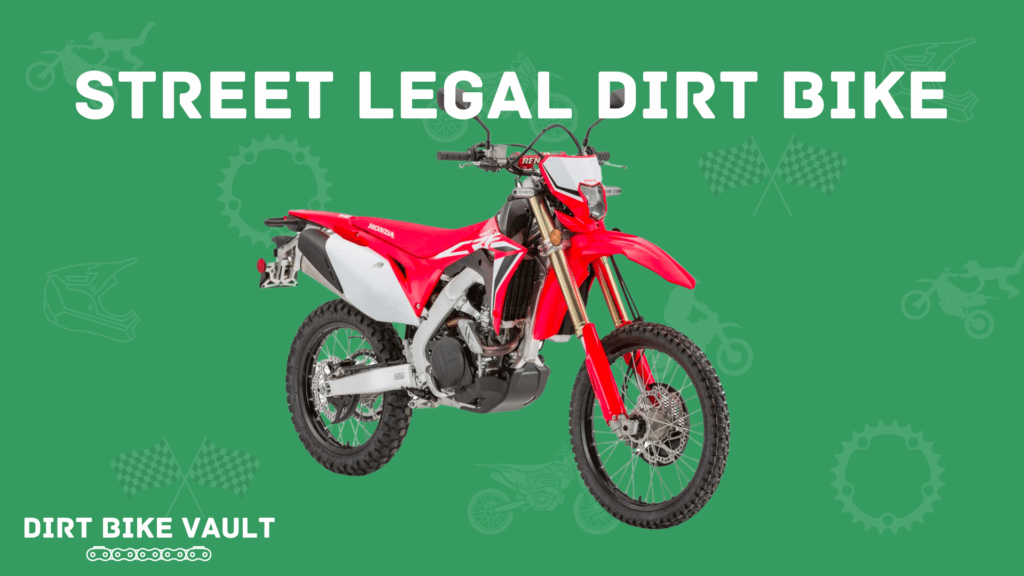Dirt bikes are motorcycles for specific types of riders. They are usually for enthusiasts of off-road riding or racing and people passionate about the adrenaline of trail riding.
But what if you’re passionate about dirt bikes and want to be able to ride your dirt bike on public roads? It is possible, but you would need to own a street legal dirt bike in order to do that.
That is precisely the topic of this article, and in it, I will cover all the aspects of street legal dirt bikes, including how to make your own dirt bike street legal and what to look for if you’re deciding to purchase a pre-made street legal dirt bike.
Let’s get started.
Street Legal Dirt Bike – A Brief Introduction
A street-legal dirt bike is a dirt bike that meets all of the necessary law requirements for you to ride it on streets or highways. In other words, this is a dirt bike you can adapt to traffic riding conditions.
Think blinkers (in some cases), headlights, tailights, etc.
There are several dirt bike types. Some have been designed exclusively for off-road riding, while others have been factory-made for both on- and off-road conditions.
If you’re starting with a dirt bike designed exclusively for off-road riding, like a Honda CRF450R,, it willneed to be adapted to street riding conditions. An example would be the YZ450F supermoto kit.
If you’re starting off with one that is already a dual-sport, you’re much closer to hitting the road, and dirt.
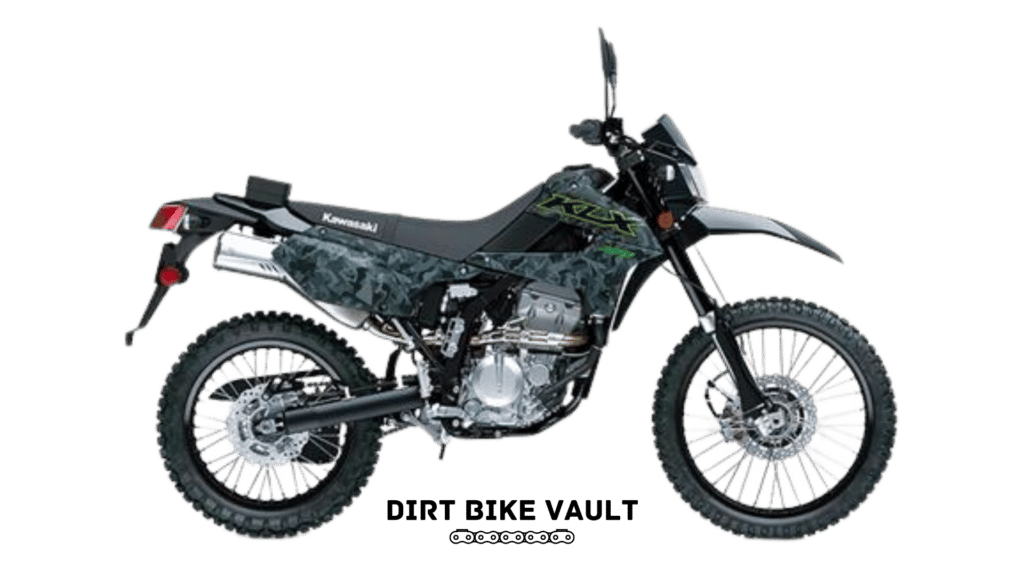
Let’s take a deeper look at some of the types of dirt bikes and how you can legalize a dirt bike for street riding.
Types of Dirt Bikes
To get a general idea, you should know that there are eight different types of dirt bikes:
- Trail dirt bike – designed for mainly riding on dirt trails
- Motocross dirt bike – meant and designed for off-road racing (motocross, supercross, arenacross, etc.)
- Enduro dirt bike – high-performance dirt bikes that can to endure severe off-road riding conditions
- Dual-sport bike – meant for both on- and off-road riding (most versatile, but least specialized)
- ADV (adventure) bike – mainly designed for street riding and occasional dirt riding
- Trials dirt bike – meant for competitive trial riding, where the rider needs to pass through obscure and difficult obstacles
- Supermoto bike – a classic enduro/dirt bike with sports tires, modified for road riding
- Small (child) dirt bike (also known as pit bikes) – small engine displacement dirt bikes meant for children and smaller riders
Are dirt bikes street legal?
When someone mentions a traditional dirt bike, you should know that dirt bikes are not legal for street use by default.
Why aren’t dirt bikes legal to ride on public roads?
It’s because they lack several key components (parts) that enable them to be ready for traffic conditions.
In other words, dirt bikes threaten public road safety without the proper equipment, which is why they are illegal to ride in or around traffic.
What makes a dirt bike street legal?
For a dirt bike to be street-legal, it needs to have the following components installed and working:
- Proper head and tail lights
- Turn signals on the front and rear
- Rearview mirrors on both sides
- A warning device (horn)
- Tires for both on- and off-road riding (DOT-certified)
- An analog or digital speedometer/odometer
- A registration and license plate
Different states may have different requirements, but almost all require a dirt bike to have these components installed before you can legalize it for street use. I will look at each of them separately further down the article.
Pros and Cons of Street Legal Dirt Bikes
Riding a street legal dirt bike has its pros and cons. Here are the most important ones to consider:
Pros
- It’s fun and easy to ride because of its low weight (compared to a traditional motorcycle) and relatively powerful engine
- It’s relatively sturdy and durable
- It is ideal for short-distance commuting, like riding to work
- You don’t need to worry about loading it onto a pickup truck every time you want to ride the trails
Cons
- It has a limited speed, making it unsuitable for highway riding
- It’s not suitable for rainy or snowy conditions
How to Make a Dirt Bike Street Legal
I briefly discussed in the previous sections how to make a dirt bike street legal, shortly naming all the required components.
This section will cover all the components that make a dirt bike street legal, but in more detail. In other words, we will look at each part separately, overviewing its characteristics.
Here’s what you need to install on your dirt bike to make it street-legal:
Headlight
A headlight that can project high and low beams is a must for street-legal dirt bikes in almost any country or state.
An important thing to note is that the headlight must be DOT certified, meaning that they have been examined, tested, and approved by experts.
The headlight must be placed at a certain height, ideally between 24 and 54 inches from the ground. A high beam should be mandatory, as it contributes to increased safety of both the driver and third-party traffic subjects.
You should place the commands for the headlight in adequate and visible reach. You must also easily change between high and low beams from a riding position without taking your eyes off the road.
Here is an example of motorcycle headlight requirements according to the Revised Code of Washington: RCW 46.37.523 and RCW 46.37.524.
Tail/Brake Light
A dirt bike must have an adequate DOT-certified tail/brake light to be street legal.
You must place the tail light at an appropriate height, between 15 and 72 inches above the ground. The tail light must operate at all times when the bike is running and can also aid in illuminating the license plate number.
The brake light must give a light strong enough so that it will be visible to all third parties in traffic. It must be connected to both the front-right handbrake and the rear-right brake.
Here is an example of motorcycle tail/brake light requirements according to the Revised Code of Washington – RCW 46.37.525.
Turn Signals
Turn signals are not obligatory in every state or country, but it’s a smarter choice to have them installed on your dirt bike. They must also be DOT certified.
You should install the turn signals at the height of the headlight in the front and the tail light in the rear.
There should be two turn signal lights in the front and two in the rear, adequately spaced apart, giving out turn signals with a light amber color.
You should place the switch for the turn signals close to the left grip for easy access and signaling.
Here is an example of motorcycle turn signals requirements according to the Revised Code of Washington – RCW 46.37.200.

Rearview Mirrors
Rearview mirrors are also obligatory when making a dirt bike street legal. Some states require only one rearview mirror on either side of the steering handle, while most require two on both sides.
When equipping your dirt bike with rearview mirrors, make sure you purchase metal instead of plastic ones. Plastic ones are susceptible to a lot of vibration, which will distort the image when riding, and you won’t see what’s behind you clearly.
Here is how rearview mirrors on a motorcycle are regulated by the Revised Code of Washington – RCW 46.37.530.
Horn
You must also equip a dirt bike with a proper horn to make it legal for street riding.
Most state laws require that the horn be electric and give out a loud enough signal so others can hear it for several hundred feet in normal conditions.
You should wire an electric horn directly to the dirt bike’s battery and mount the switch close to the left grip.
Place the horn near or under the headlight, facing the front of the road.
Here is an example of how the Revised Code of Washington regulates horns and warning devices on motorcycles – RCW 46.37.380.
Tires
You need to pay close attention to tires when making your dirt bike street-legal.
Choosing the right tire type is highly important, along with a quality tire manufacturer. Tires must also be DOT-certified, so take note of that.
ADV/Dual sport tires would be your best bet, as they are optimized for both on- and off-road riding conditions. They are constructed in such a way to offer a smooth riding experience on normal roads and highways but also attach fairly easily to the loose surface of off-road trails without slipping.
How to choose the best dual sport tires?
To choose a dual sport tire, you have to look at the off- and on-road percentage that the tire has. This value represents the terrain for which the tire was made to run.
The off- and on-road percentages mainly depend on the knobs; the larger the knobs, the more the tire is meant for off-road use. The smoother the tire, the more it leans toward on-road use.
The best dual sport tires you can choose
Depending on your preference, riding habits, and price range, some of the best dirt bike dual sport tires you can choose are:
- Dunlop D606 (90% off-road and 10% on-road)
- Pirelli MT21 (90% off-road and 10% on-road)
- Bridgestone Trail Wing TW22 (80% off-road and 20% on-road)
- Continental Twinduro TKC80 (60% off-road and 40% on-road)
- MotoZ Tractionator ADV (50% off-road and 50% on-road)
- Michelin Anakee Wild (50% off-road and 50% on-road)
- Continental Trail Attack 2 (15% off-road and 85% on-road)
Here is an example of a dual sport tire (Pirelli MT21 from above) that is more designed for off-road riding:

Here is an example of a dual sport tire (Continental Trail Attack 2 from above) that is more designed for on-road riding:

Tachometer and Speedometer/Odometer
Even though some states don’t regulate the placement of speedometers and tachometers in motorcycles, most do. This means that you also have to check whether this is required in your state and if so, place both a tachometer and a speedometer on your dirt bike to make it legal.
A tachometer measures the engine’s RPM. The speedometer measures the bike’s speed (mph or km/h), and the odometer measures the distance you’ve traveled in miles or kilometers.
Depending on your preference and price range, you can install an analog or a digital tachometer and speedometer. Digital ones are more accurate, depending on their quality and price.
Placing these instruments on your dirt bike is a good idea, even if the law doesn’t require them. Knowing the speed you’re riding, along with the engine RPMs, is always better than riding blindly with no instruments.
Windshield (optional)
Installing a windshield on your dirt bike is optional, and not many states regulate it as a legal requirement.
For example, RCW 46.37.530 states that a windshield is mandatory only if the rider is not wearing protective goggles, glasses, or a helmet. This means that if you plan on wearing a protective helmet when riding, you don’t need to install a windshield on your dirt bike.
However, installing a windshield is a good idea, especially if you’re planning on doing a lot of highway riding with your dirt bike. It will protect you from the wind and divert airflow up and away from you as much as possible.
License plate and bracket
Displaying a license plate, which shows that your dirt bike is registered and legally enabled to ride on street roads, is also mandatory.
So, to be able to mount the license plate, you need to purchase a license plate bracket compatible with your dirt bike. You can look for a bracket for your specific dirt bike model online or use a custom bracket to mount the license plate.
Once you mount the bracket to the bike, you can place your license plate on it, showing the authorities that it has been legalized for street use.
You can also look at how the Washington State Department of Licencing regulates the entire process of obtaining a street-legal license for off-road vehicles. It mentions all the criteria I’ve also included in the previous sections.
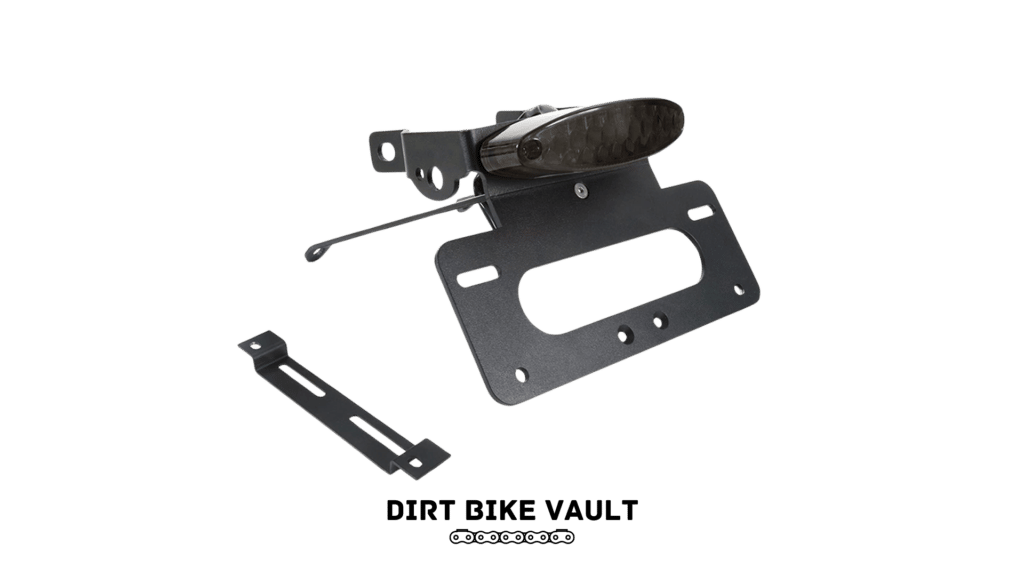
Choosing a Factory-Designed Street Legal Dirt Bike
If you don’t own a dirt bike and wish to purchase one for off- and on-road riding, then this and the following sections are for you.
In this section, I will analyze and discuss some of the most important components of dirt bikes, like the engine, the suspension, and the frame.
I will not cover the specific tires that a dual sport dirt bike has because I’ve already mentioned them in the previous sections.
Engine
The engine is the beating heart of any motorcycle. It is the part that gives life to the bike and decides how powerful and fast it is.
The size and type of the engine will vary, depending on the type of dirt bike and what it’s meant for.
For example, beginner dirt bikes have a small displacement engine with only one piston, making them less powerful and suitable for beginners. On the other hand, enduro or supermoto dirt bikes have a larger and more powerful engine that delivers higher horsepower and torque.
But how is engine displacement measured? And how does the engine operate? Let’s have a look.
Engine displacement
Engine displacement is the calculated size of the engine in cubic centimeters. It is a way to distinguish engines by their size, which is the size of the piston inside the cylinder block.
The engine displacement is calculated by measuring the piston’s bore and multiplying that value by the length of the crankshaft’s stroke. The resulting value is multiplied by the number of pistons to get the final engine displacement number.
Most dirt bikes have only one piston, but dual-sport dirt bikes may have two or even four, depending on the model.
It is recommended that children and beginner riders start with small engine-size bikes, ranging from 50cc-125cc. They have a softer power delivery and are less powerful overall.
Intermediate and advanced riders ride dirt bikes anywhere from 250cc to 500cc, depending on their preference and use.
Engine operation
The engine operation is the other important factor when choosing a street-legal dirt bike.
There are two engine types depending on how they operate, and each has its benefits and downsides.
2-Stroke Engines
2-stroke engines don’t have valves, and the piston makes a two-stroke movement to complete an operating cycle. The crankshaft rotates twice for a complete operating cycle, once when the piston goes up and down for compression and again when the spark plug is ignited.
2-stroke engines deliver more power, which is what a dirt bike needs when you ride it on trails. They can also make the bike go really fast, but that mainly depends on the engine’s displacement and the bike’s weight.
The downside of 2-stroke engines is that they are not as durable as 4-strokes, as fresh air and gasoline mixture is constantly mixed with exhaust gasses, resulting in unclean combustion and lowered engine lifespan. (That said, they’re much cheaper to fix and/or rebuild, if/when needed.)
Engine oil and gas are also mixed inside the combustion chamber, which degrades the lifespan of a 2-stroke engine even further.
Smaller engine displacement dirt bikes are often the ones to have a 2-stroke engine.
4-Stroke Engines
Larger engine displacement dirt bikes tend to have a 4-stroke engine.
4-stroke engines have valves that open and close to inlet the gas and air mixture and outlet the exhaust gasses. In this engine type, the piston completes an operation cycle by performing four strokes:
- Intake
- Compression
- Power
- Exhaust
4-stroke engines have a steady power delivery and are the ideal choice for both off- and on-road riding. They are also more durable and long-lasting because of the clean mixture and combustion of gases in the combustion chamber.
Suspension
When we talk about the bike’s suspension, you need to know that classic bikes like the trail, enduro, or motocross have a softer suspension with more travel. On the other hand, dual-sport bikes have a harder suspension with less travel.
The softer the suspension and the more travel it has, the better the bike will perform in off-road conditions. So if you’re looking to purchase a street-legal dirt bike, you must pay attention to the hardness of the suspension.
Dual-sport bikes have a harder suspension with less travel and are meant for both off- and on-road riding. This harder suspension provides more stability on the street road and keeps it “glued” to the ground.
A harder suspension may result in a worse off-road riding experience, but it will reduce the bike’s risk of slipping on the street and highway roads.
Frame
A classic dirt bike has a lightweight and compact frame. A smaller frame lowers the bike’s weight, making it easier to maneuver on rough terrain. Classic dirt bikes also have higher ground clearance to avoid hitting the ground when landing from jumps on trails.
However beneficial this may sound, such frame characteristics are unsuitable for street-legal dirt bikes. This is why dual sport bikes have a larger frame with less ground clearance and are heavier overall.
With a larger and heavier frame, dual sport bikes are ideal for off- and on-road riding conditions. They provide more stability and control when riding on-road, but they can still clear most bumps when riding off-road.
Dual Sport Street-Legal Dirt Bike Brands and Models
In this section, I will cover some of the best dual sport bikes that are street-legal directly from the factory.
The information you learn here will help you understand the different brands and models of street-legal dirt bikes and help you decide which one to purchase.
Honda
Honda is one of the best Japanese motorcycle manufacturers in the world. It produces many different types of motorcycles, including dual sport bikes.
Let’s cover some of their current available models that you can purchase.
CRF300L – Suitable for beginner riders
The CRF300L is a Honda street legal dirt bike with a small-engine displacement. It replaced the CRF250L, offering more power, torque, and even better fuel efficiency.
It has a 4-stroke, single-cylinder engine and a style based on the CRF450R motocross bikes. The CRF300L offers increased levels of comfort, both on- and off-road riding conditions.
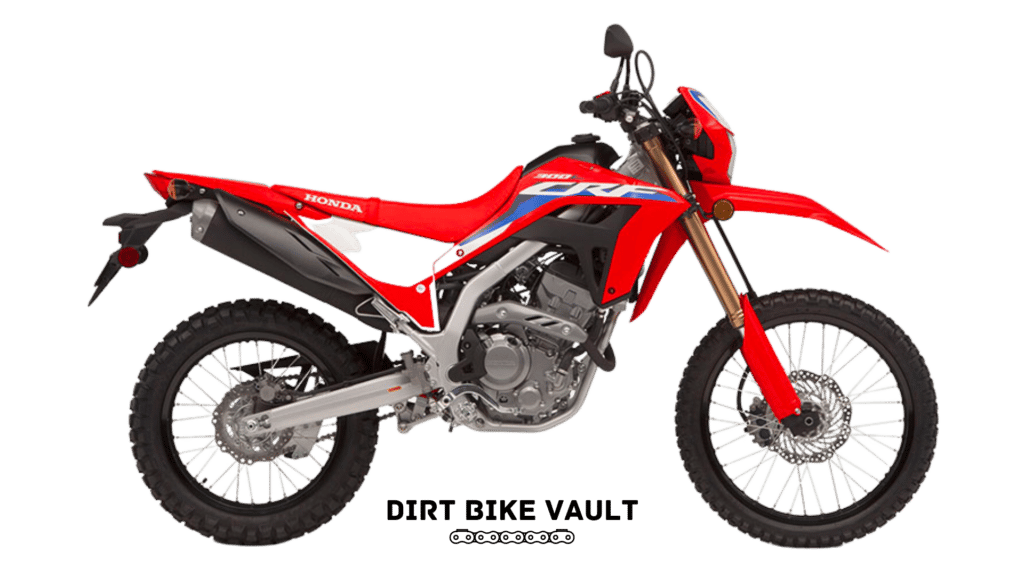
CRF300L Rally – More trail targeted
This enhanced version of the stock CRF300L is more oriented toward off-road riding. It has the same engine displacement, power, and torque, but where it differs is in the suspension.
The CRF300L Rally has a softer suspension with more travel. Its brakes are also stronger to provide more stopping power when going downhill.
The front of the bike is redesigned, with an added windshield for more protection. The engine compartment is sealed for protection against rough terrain as well.
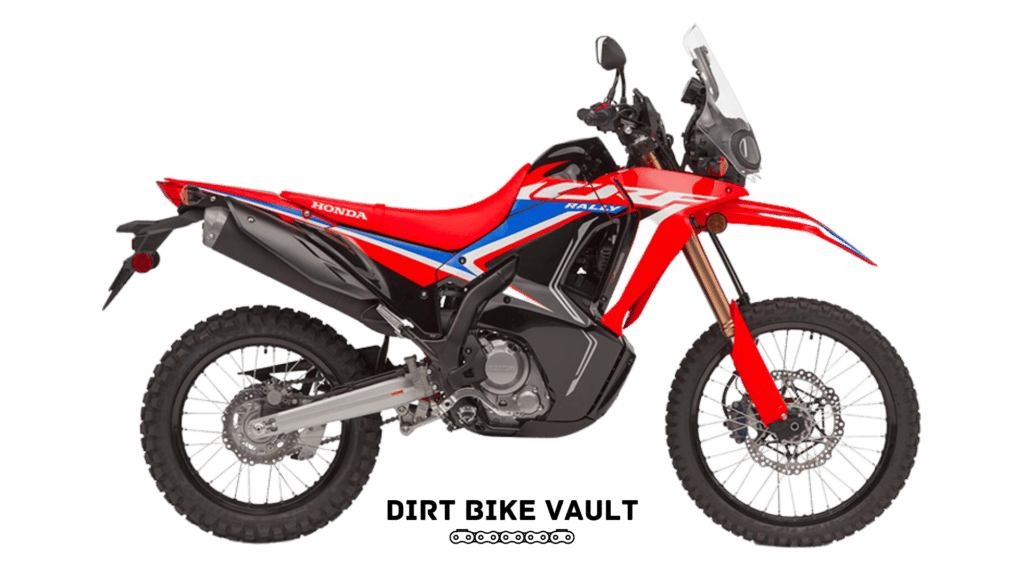
CRF450RL – Suitable for country commuting & off-road riding
This dual sport bike model by Honda has a frame and engine derived from the CRF450R motocross and CRF450X enduro bikes. Its single-cylinder, 4-stroke, 450cc liquid-cooled engine can deliver 38.21 horsepower at 7.500RPM and 37Nm of torque at 6.500RPM.
Such engine power, paired with a six-speed gearbox, makes the CRF450RL ideal for intermediate and advanced riders who wish to ride on- and off-road. It is highly ergonomic to ride and offers great handling in all conditions.

XR650L – Suitable for off-road riding
The XR650L is Honda’s fourth dual sport bike with the largest engine displacement. It has a 644cc air-cooled, single-cylinder, four-stroke engine with a dry sump.
The higher engine displacement is beneficial because of its dry sump oil cooling method, but it’s not that beneficial when delivering the maximum horsepower. That being said, the XR650L can deliver 40 horsepower, close to the CRF450RL.
But where the XR650L outperforms the CRF450RL is in the amount of torque, producing a maximum of 64Nm of torque. This makes the XR650L a lot more suitable for off-road purposes.

Yamaha
Yamaha is another well-known Japanese motorcycle manufacturer and a direct competitor of Honda. Its dominance in the motorcycle world is renowned, and it produces different motorcycle types.
Yamaha offers two dual-sport motorcycles:
TW200 – Suitable for all terrains
The TW200 packs a 196cc, air-cooled, 4-stroke engine with a 5-speed gearbox.
Because of its characteristic flat tires, this bike is considered one of the most versatile dual sport bikes Yamaha has ever made. It can cover great distances across all kinds of terrain, offering great comfort and an adequate amount of power.
Along with its unique tires, the suspension of the TW200 has a long travel and soft dampening, allowing the bike to absorb all kinds of bumps on the road.
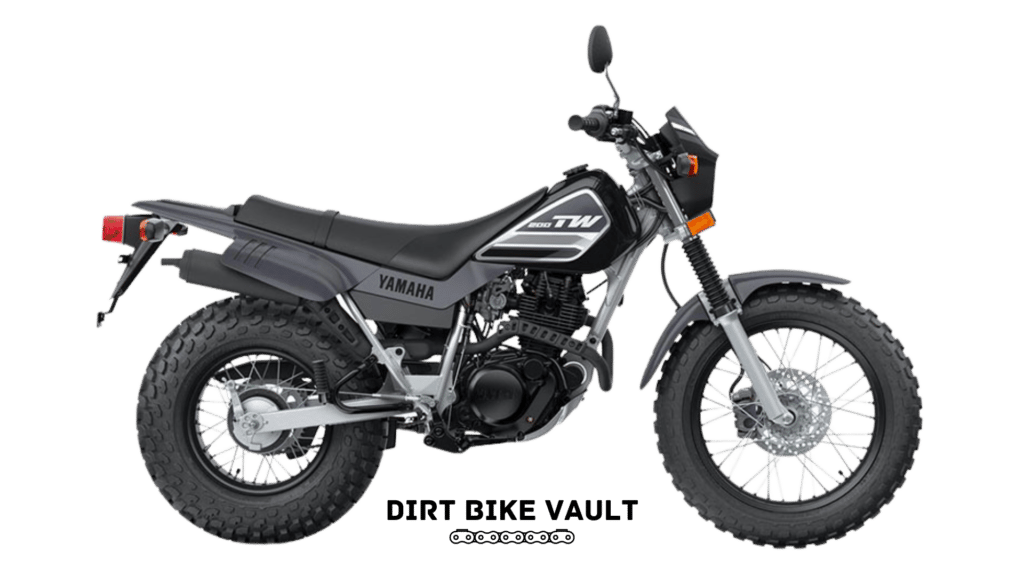
XT250 – A great dual sport bike for beginners
The XT250 is a dual sport bike from Yamaha with a more standard dirt bike look. Even though it is street legal, it is more tailored toward off-road than on-road use.
The bike has an air-cooled, 249cc, 4-stroke engine and is paired with a 5-speed gearbox. Its power delivery is smooth and less aggressive, which makes it an ideal dual sport bike for beginner riders.
The XT250 is an excellent, classic-looking dual sport dirt bike you can enjoy learning on and riding across. Its long travel suspension will provide excellent dampening, and the higher ground clearance makes it a great off-road motorcycle.
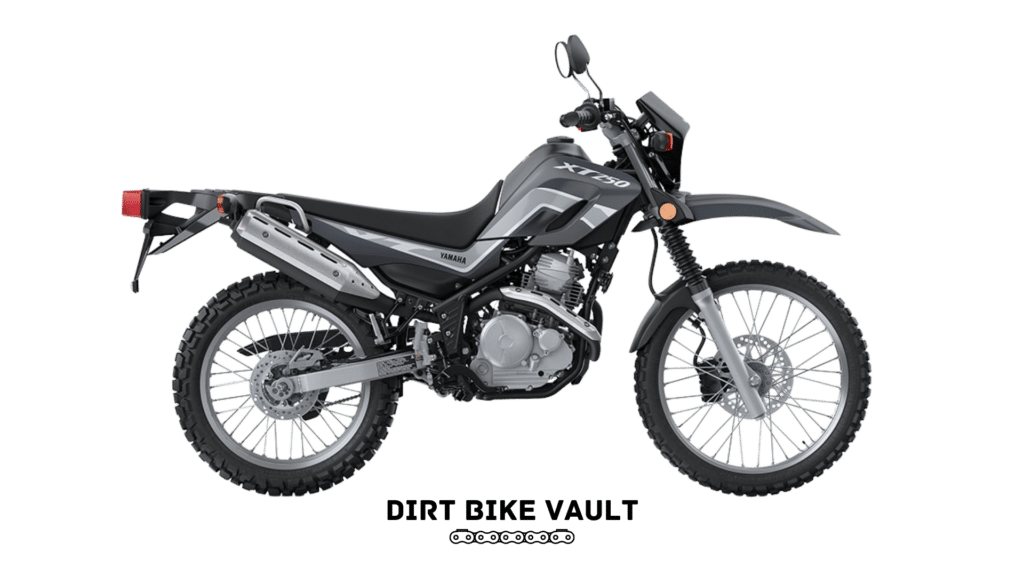
Kawasaki
Kawasaki is the third Japanese motorcycle manufacturer I’ve included in this list. It is known worldwide for producing cruiser, adventure, and sport motorcycles, but it doesn’t fall short in the dual-sport bikes category.
Kawasaki has three dual sport bikes meant for both on- and off-road riding:
KLX230 – Ideal for beginner riders
If you’re a beginner rider, then Kawasaki’s KLX230 is a great bike to learn to ride on and off the trails. It is powered by a 233cc, single-cylinder engine with ideal low to mid-range power delivery.
The strong side of the KLX230 is its tough but light chassis. It makes the bike super easy to maneuver for beginners. Thanks to its lowered seat height of 32.7 inches, the bike is also ideal for shorter riders who want to try some off-road riding.
The KLX230 stock model comes in two other variants: the KLX230S and the KLX230 SE. You can check these bikes’ characteristics from the link I’ve provided.

KLX300 – Geared toward off-road use
The KLX300 has similar low and mid-range power delivery as the KLX230, but where it outperforms is the top-end pulling power. It achieves this extra top-end power from the larger engine displacement and the dual overhead camshaft (DOHC).
Because of its similar frame and weight to the KLX230, the KLX300 is also a bike suitable for beginners, but you can also ride it if you’re an intermediate or advanced rider.
The KLX300 will make your off-road riding experience pleasant because of the high ground clearance and long travel suspension.
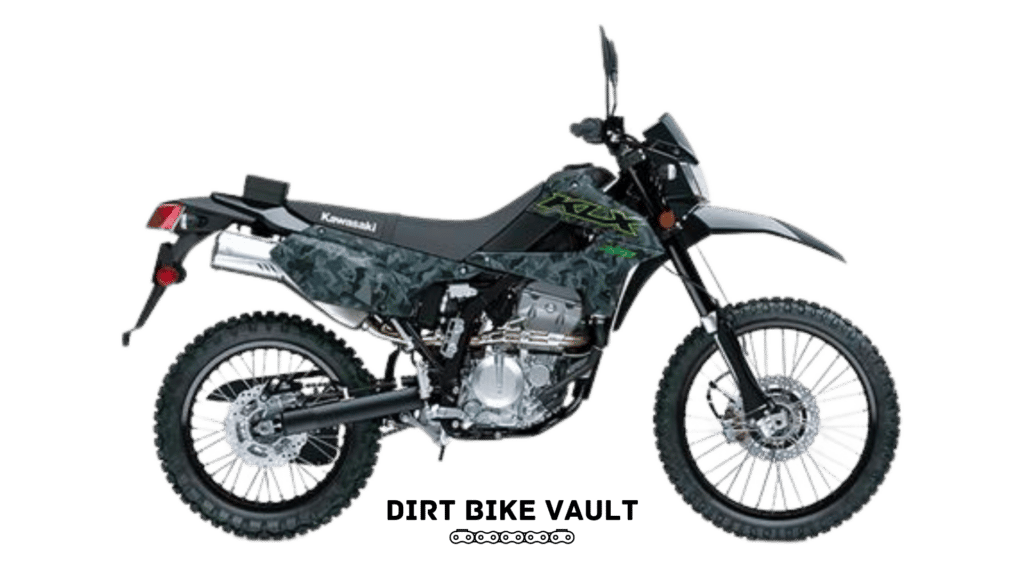
KLR650 – A great bike for adventure riding and commuting
If you’re looking for a bigger dual-sport motorcycle that will take you on adventurous journeys, then the KLR650 might be an ideal choice.
It has a 652cc, single-cylinder engine with a fairly low 34.6 horsepower for that engine displacement size. Because of that power, the KLR650 provides smooth acceleration, a convenient top speed, and incredible comfort.
Several upgraded models of the stock KLR650, like the KLR650S, KLR650 Traveler ABS, and the KLR650 Adventure. Each has its own features that make it suitable for different riding environments.
Because of its larger size and weight, the KLR650 model from Kawasaki is an ideal dual sport bike for adventure riders and one which will not tire easily before rough terrain obstacles.

KTM
KTM is a well-known and renowned Austrian motorcycle manufacturer specializing in the production of off-road motorcycles.
It offers a variety of dual sport bike models that are highly popular among many beginner and experienced riders. Let’s cover some of the most popular ones.
150 XC-W (2-stroke) – Great beginner dual sport bike
The 150 XC-W is an excellent dual sport bike for beginners. Its 2-stroke engine delivers adequate amounts of power, making it easily controllable by someone who sits on a motorcycle for the first time.
The high ground clearance of the bike makes it highly compatible with off-road riding, and the light frame will provide sturdiness and stability while performing jumps.
Even though the 150 XC-W is a small displacement bike, it packs enough power to handle heavy-duty trails and is also ready to be ridden on the streets.
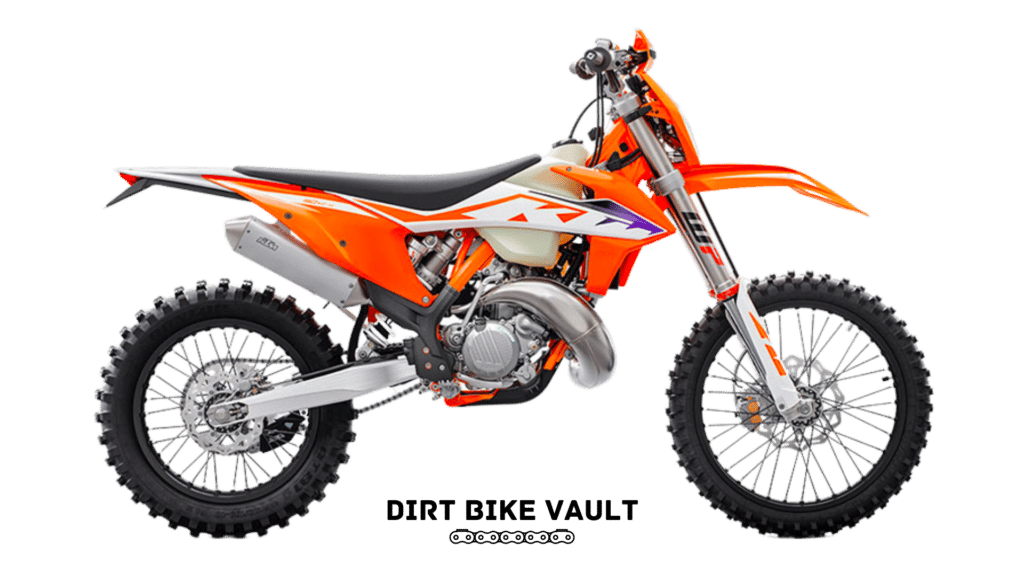
300 XC-W (2-stroke) – Geared toward off-road and trail riding
The big brother of the 150 XC-W, the 300 XC-W features a larger engine and more low and mid-range power delivery.
Because it has increased low-end torque and is lightweight, the 300 XC-W is more geared toward off-road and trail riding. The 2-stroke 300cc engine will easily deal with those high hill trails, while the suspension will provide great dampening on any road bumps and holes.
The 300 XC-W is a great bike for intermediate and advanced riders who want to try relaxed and easy-to-handle off-road riding.
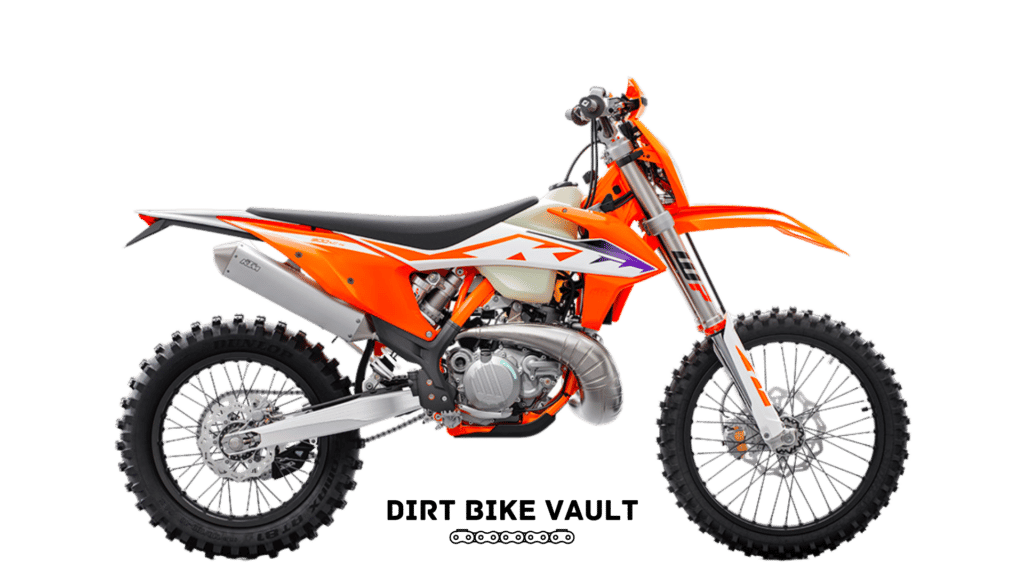
350 EXC-F (4-stroke) – Suitable for city and off-road riding
If you’re more into 4-stroke dual sport bikes, then the 350 EXC-F will be the first choice to consider. It has adequate low and high-end power capability and is considered a highly capable motorcycle both on and off the road.
The 350 EXC-F has a DOHC, fuel-injected 4-stroke engine with an incredibly lightweight, which compliments its versatile nature. Because of this, it is considered by many riders to be a smaller displacement bike.
The lightweight Chromoly steel frame makes this bike highly durable and able to withstand any riding impact. The front suspension has a travel of 48mm, which increases the comfort for the rider in off-road riding conditions.
As a whole, the 350 EXC-F is an excellent choice for everyday country commuting and frequent trail and off-road riding.
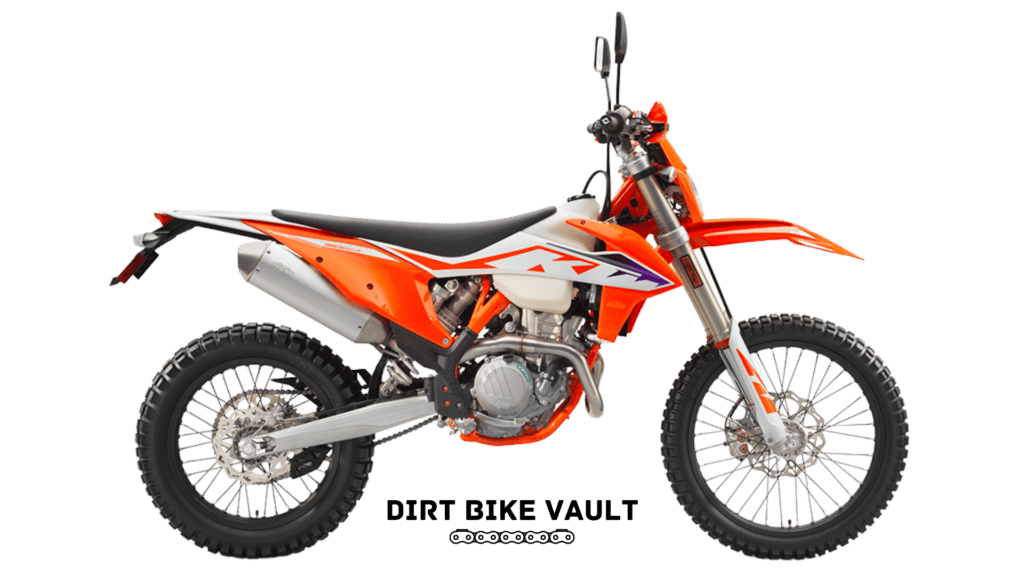
500 EXC-F (4-stroke) – Suitable for off-road riding and commuting
The 500 EXC-F is the most powerful dual-sport motorcycle that KTM offers, and they call it the “sledgehammer”.
It has a 510cc, single-cylinder engine with a single overhead camshaft (SOHC) and power delivery of 58 horsepower.
You might think that with such power, this bike might be too aggressive to ride, but it has an incredible power-to-weight ratio. This means that its lightweight but durable chassis, paired with the high-travel suspension, makes the 500 EXC-F an easy-to-handle and highly maneuverable bike.
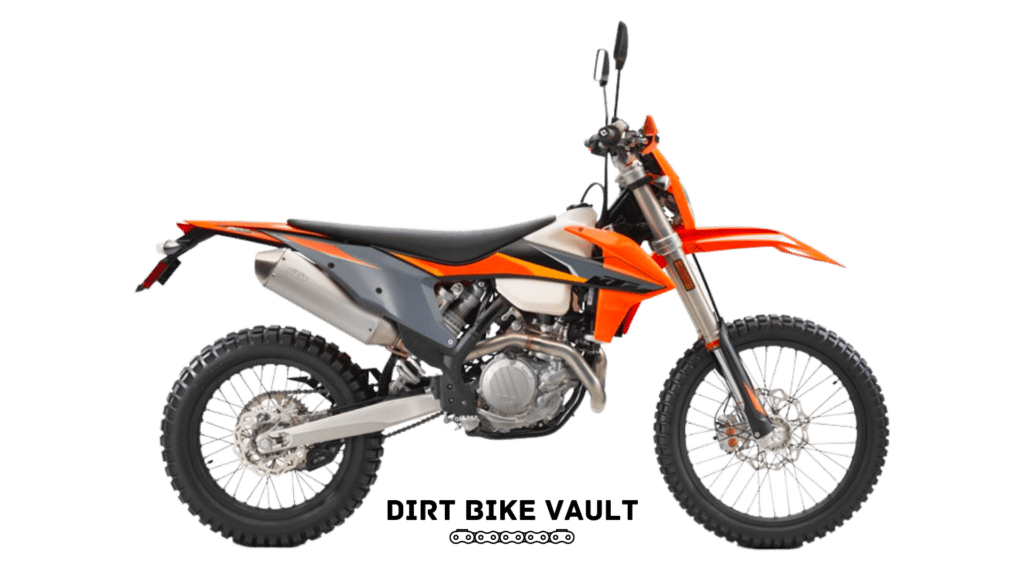
Suzuki
The Suzuki Motor Corporation was founded in 1909 in Japan, and since then, it has slowly gained a reputation as one of the most renowned motorcycle manufacturers in the world. It currently offers two dual-sport motorcycles on the market.
DR-Z400S – A good choice for light off-road riding
The DR-Z400S is a mid-range dual sport motorcycle from Suzuki. It pairs extremely well with other competitor 300-400cc bikes while packing a classic 80s look.
Suzuki’s engines have always been reliable and proven, and the 398cc of the DR-Z400S is nothing less. It is a liquid-cooled powerplant, delivering 33.4 horsepower through its 5-speed gearbox transmission.
The frame of the DR-Z400S is a narrow chrome-moly alloy with increased strength and durability, making the bike light and easily maneuverable.
The DR-Z400S is suitable for intermediate and experienced riders who wish to take a relaxing off-road trip, knowing they can rely on an already proven machine.
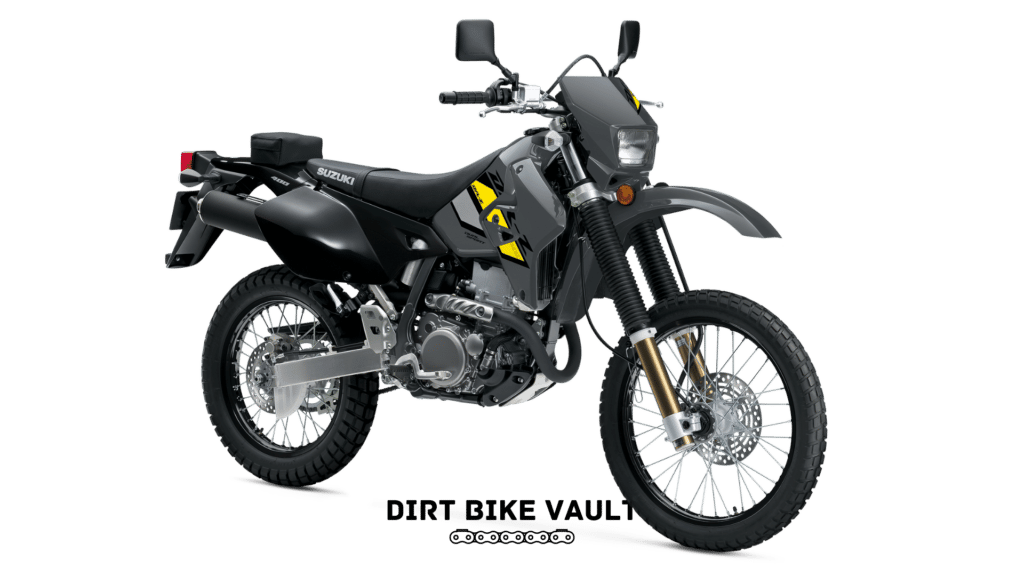
DR650S – A great all-rounder bike
An all-purpose motorcycle, the DR650S is Suzuki’s offer to riders who want a dual sport bike capable of all-terrain riding.
With a 644cc, single-cylinder, oil-cooled engine, the DR650S can deliver a maximum of 35 horsepower and 54Nm of torque. With such an impressive torque output, this bike can conquer any terrain and is also ideal for street riding and commuting.
The riding experience, both on- and off-road, will be made even better by the rigid frame, paired with the height-adjustable front and rear suspension for maximum dampening, depending on the riding conditions.
The DR650S is an all-rounder suitable for commuting and heavy off-road riding.
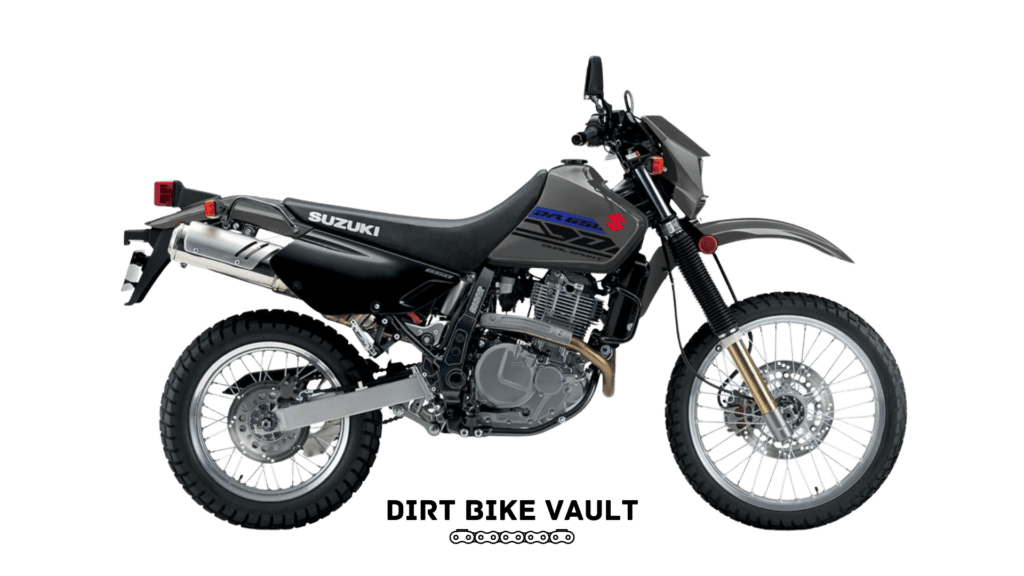
Husqvarna
You may have heard that Husqvarna is a company producing high-quality chainsaws. Husqvarna also makes specialized off-road vehicles, so I’ve included their two famous dual sport bike models.
FE 350 – Great for beginners and intermediate riders
The FE 350 is Husqvarna’s smaller dual sport bike with a less powerful engine. They’ve based the size and form factor of the engine on that of their FE 250 models, but with increased power and torque.
The frame of the FE 350 is a chrome-moly alloy, just like all modern dual sport bikes, but its crafted geometry gives the bike high maneuverability and great handling. This is why the FE350 is a great bike for beginner and intermediate riders.
As far as suspension is concerned, the FE 350 is geared predominantly for off-road riding because of the long-travel, split-damping suspension.
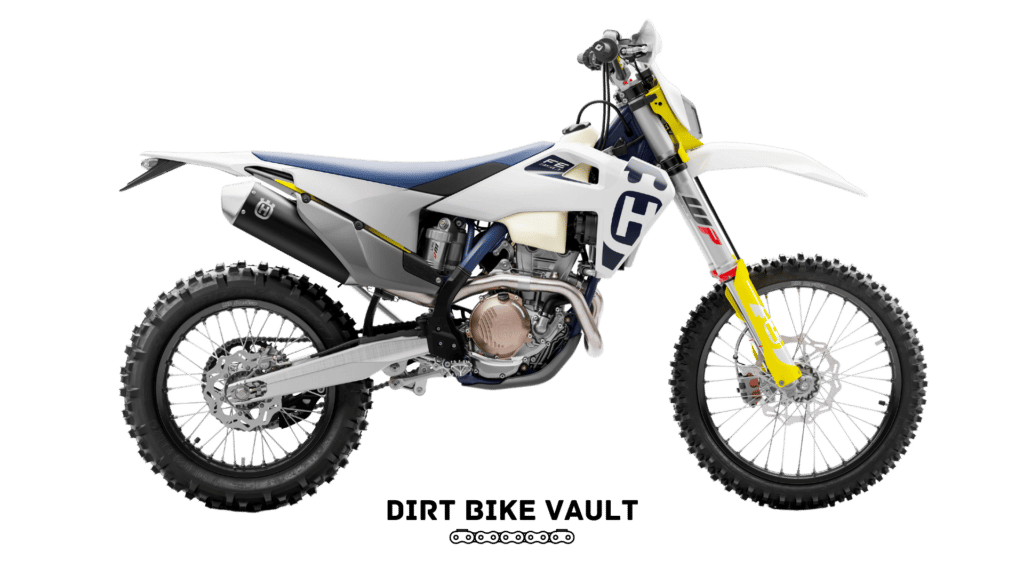
FE 501 – An ideal all-rounder dual sport bike
The second, more powerful dual sport bike from Husqvarna is their FE 501.
Just like Suzuki’s DR650S, this bike model from Husqvarna is also an all-rounder. It’s highly versatile and can conquer all terrain types with little effort. It does this because of its 510.9cc, single-cylinder engine that delivers close to 50 horsepower.
As far as chassis and suspension are concerned, the FE 501 is almost identical to its smaller brother, the FE 350.
The main difference between them is the engine size and power output, which make the FE 501 a better choice for those who want bulletproof reliability on and off the road.
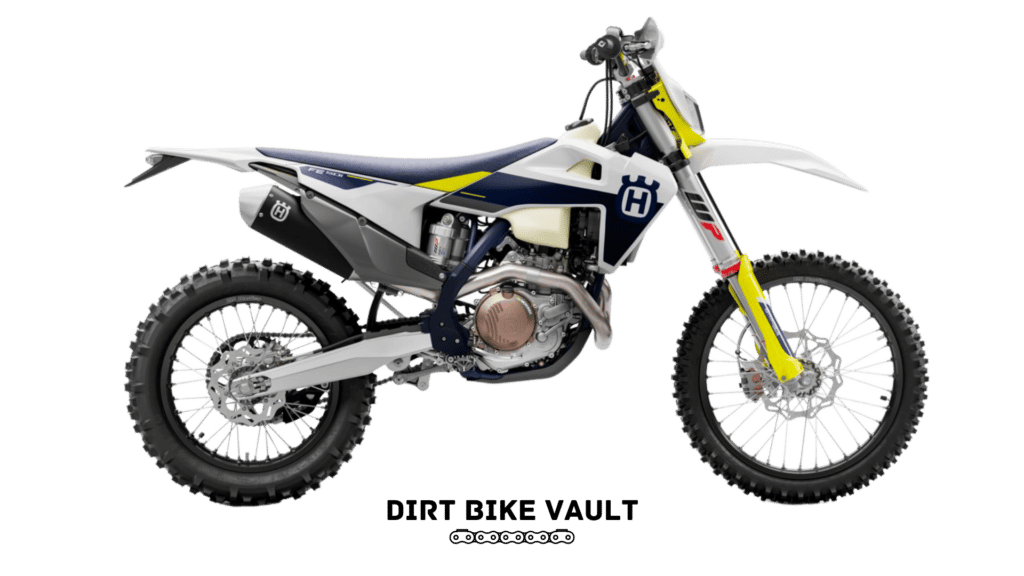
Why Should You Consider Purchasing a Street Legal Dirt Bike?
Before I finish this article, I want to address why you should consider purchasing a dual-sport bike instead of a classic enduro/dirt bike. Here’s what you should know:
Versatility
First of all, dual sport bikes are more versatile than classic enduro/dirt bikes because you can ride them on- and off-road with no restrictions.
This means you don’t have to tow your dual sport bike to the track; you can simply ride it there through public streets and highways. This will save you gas, money, and time to load and unload the bike.
No custom modifications
Dual sport bikes are manufactured to be street-legal, so you don’t have to purchase any additional components. Even if you do, the cost will be minimal, as the main components will already be installed on the bike.
Some of the equipment that might be lacking on a dual sport bike would be the turn signals, license plate base, or windshield, which are quite cheap to purchase later.
One bike for all purposes
The versatility of the dual sport bike makes it ideal for all purposes.
If you’re a frequent commuter and live in the country, you can add traveling panniers to the bike to increase storage space and go shipping with it.
There are practically endless possibilities when you have an all-rounder, street legal dirt bike.
Frequently Asked Questions about a Street Legal Dirt Bike
Dual sport dirt bikes are street legal as they come, but you can also make most full size dirt bikes into dual sports, therefore street legal, by adding the required parts.
Yes, you can turn a dirt bike into a street legal bike with the right parts (directionals, head light, tail light, etc.)
Normal dirt bikes, as you buy them, are not street legal in Alabama. However, you can buy a dual sport dirt bike, which is street legal in Alabama. You can also buy the necessary parts to make a normal dirt bike street legal.
No, you cannot legally ride your dirt bike around your neighborhood. Are you going to get caught and in trouble? Most likely not, but it is still illegal. Your neighbors could complain and cause a problem (trust me, I’ve experienced it myself).
Dirt bikes are not street legal in Florida. However, you can ride dual sports legally in Florida, and you can convert your dirt bike to be street legal in Florida with the right parts.
No, you do not need a license to drive a dirt bike. However, if you would like to legally drive your dirt bike on the road, after making it a street legal dirt bike, you would need to be licensed.
As a stock dirt bike sits, a dirt bike is not street legal in Texas. Dual sport bikes can be registered and ridden on the street legally.
A dirt bike can be made street legal by adding the necessary parts, such as a headlight, taillight, directionals, horn, speedometer, tachometer, and anything else the state you’re in requires.
Stock, from the dealership, no, a dirt bike is not street legal in California. You would need to add all of the parts to meet California’s requirements, or ride a dual sport bike.
No, dirt bikes generally are not street legal in Illinois. However, dual sport bikes can be.
No, a normal dirt bike is not street legal in NY. However, with the right components, they can be made to be. Dual sport bikes can also be street legal in NY.
A traditional dirt bike is not street legal Georgia. However, you can make many full size dirt bikes street legal by adding the necessary parts and registering it. Dual sport dirt bikes can also be street legal in Georgia.
